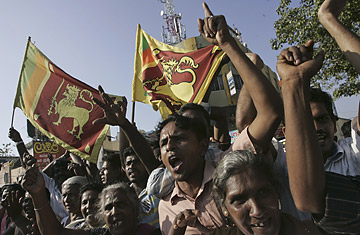
Sri Lankans hold their national flags and cheer the armed forces as they react to the downfall of Tamil Tiger rebels' de facto capital Kilinochi by bursting fire crackers in Colombo, Sri Lanka, Friday, Jan. 2, 2009.
At Kollupitiya junction in the heart of Colombo Friday afternoon, the streets filled with confetti and bursts of firecrackers. Sri Lankans were celebrating their government's claim that troops had captured Kilinochchi, the administrative capital of the Liberation Tigers of Tamil Eelam, a separatist group that has waged a 25-year struggle for an independent Tamil homeland. After a triumphant speech by President Mahinda Rajapaksa, a handful of men danced in the streets, as a drummer pounded out one of the island's raucus baila beats.
The celebrations didn't last long. Less than an hour after Rajapaksa's late afternoon speech, a suicide bomber struck the air force headquarters in the city, killing three people, including two airmen and wounding at least 32. The LTTE have not officially claimed responsibility, but the message sent by the blast was unmistakable: even if the government is close to controlling all of Sri Lanka, the guerrilla war is far from finished. "They want to take the victory spirit out," says Lakshman Hulugalle, a defense ministry spokesman and director general of the Media Center for National Security. "We can win the war, but this terror will continue for some time." (See pictures of Sri Lanka on the brink of civil war in 2006.)
Kilinochchi's importance is only partly strategic. It is one of several key areas of territory along the A9 highway, a road toward the northern tip of the teardrop-shaped island and one of the main supply routes into Mullaitivu, the thick jungle areas where the LTTE is believed to base its operations. Symbolically, Kilinochchi is more important. The 463 square mile (1,200 sq. km.) district it governs has been under LTTE control for more than 10 years, ever since the Sri Lankan Army lost a battle known as Operation Unceasing Waves in September 1998.
Within two years, the LTTE, who say they are fighting subjugation by the majority Sinhalese, had set up law courts, banks, hospitals and administrative offices — all the trappings of state that stand in defiance of Sri Lanka. But it is no longer the home of rebel leadership or military operations. "Kilinochchi was ceded by them a long time ago," says Paikiasothy Saravanamuttu, executive director of the Centre for Policy Alternatives, a public policy group based in Colombo. "Mullaitivu is a much more vital strategic asset."
Capturing Mullaitivu will not be easy. The terrain is dense jungle, and government forces will face the most experienced of the Tigers' cadres. Even if Mullaitivu were to fall, the Tigers could simply move underground, returning to the guerrilla tactics such as suicide bombings which made them famous and have contributed to the conflict's enormous death toll: more than 65,000 deaths since 1983. "Even if you occupy Kilinochchi, you're not going to defeat the LTTE as such," says Gajan Ponnambalam, a member of parliament whose party, the Tamil National Alliance, is sympathetic to the LTTE. "They'll go underground and continue the struggle in a different way."
If that happens, the Tigers may try to show their strength with retaliatory attacks timed with each new announcement of a victory by the army. "They'll want to show that they can do something in Colombo and the suburbs," says Hulugalle. The government says that Elephant Pass, another key stretch of territory on the road to the northern port of Jaffna, will be the next to fall. Colombo is bracing itself — for celebration and its consequences.
